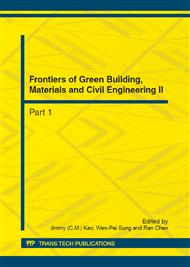p.1371
p.1376
p.1380
p.1384
p.1389
p.1393
p.1397
p.1401
p.1405
The Improved Mechanics Behavior of the FRP Deck
Abstract:
The objective of this study is to improve the stiffness and control the failure mode of the pultruded glass fiber reinforced polymers (GFRP) deck members to meet the design requirements. In this study, the authors proposed that the GFRP member was affixed by another GFRP deck inside it to form a combined GFRP deck member; an epoxy mortar was filled into some of the hollow sections of the GFRP member; and the basalt/carbon fiber sheets was wrapped around the GFRP member in order to improve the ultimate strength and stiffness and also to change its original failure mode of the GFRP member. Eight GFRP deck specimens where investigated in the three-point bending test results for their ultimate strength, stiffness, and corresponding failure modes. Finally, the Euler beam theory was used to obtain the force-displacement relationships of the GFRP members and then to compare the experimental results.
Info:
Periodical:
Pages:
1389-1392
Citation:
Online since:
August 2012
Authors:
Keywords:
Price:
Сopyright:
© 2012 Trans Tech Publications Ltd. All Rights Reserved
Share:
Citation:


